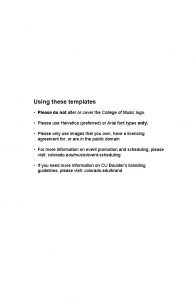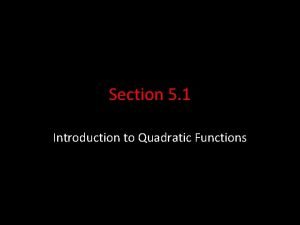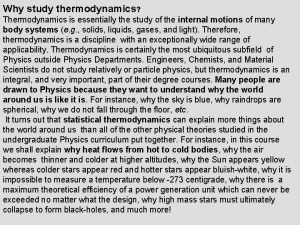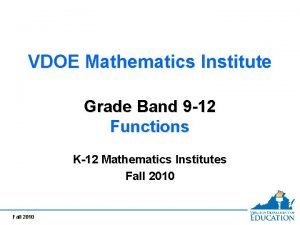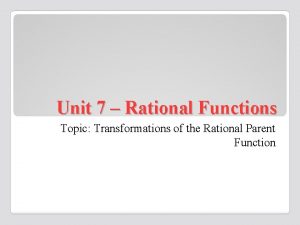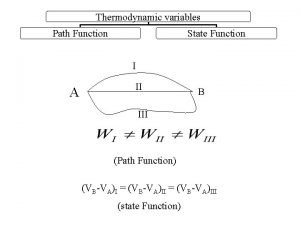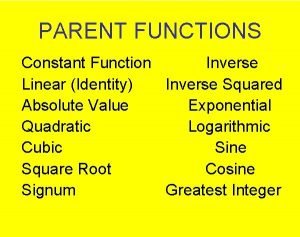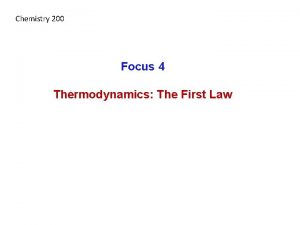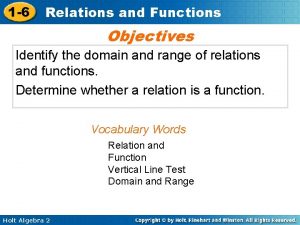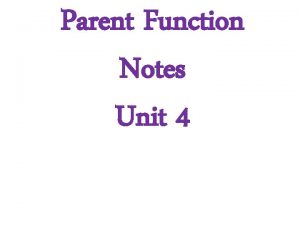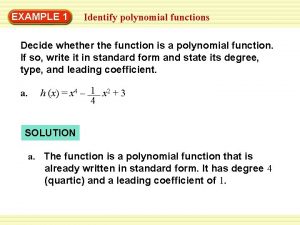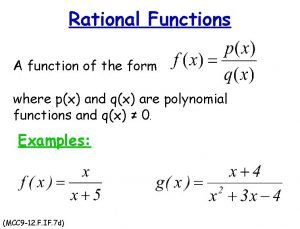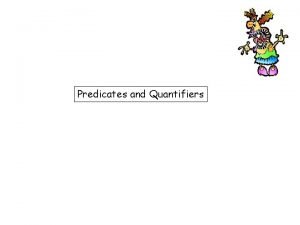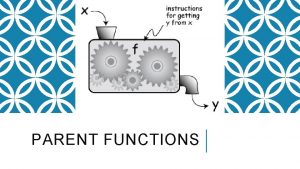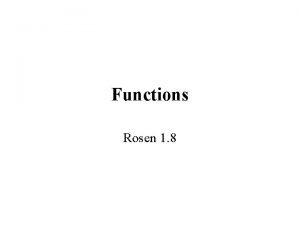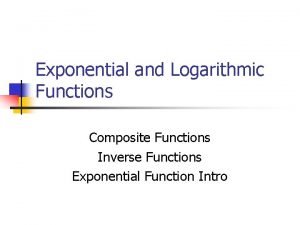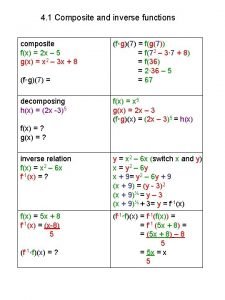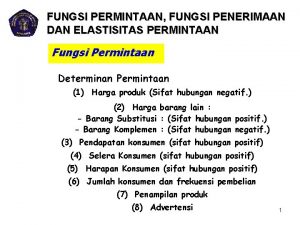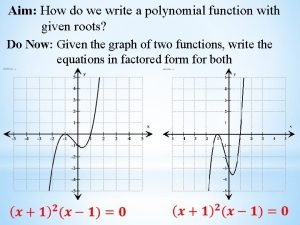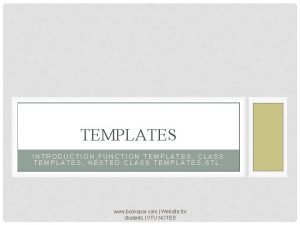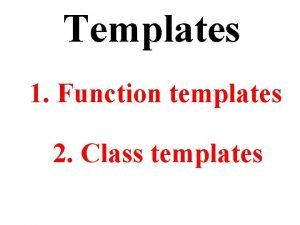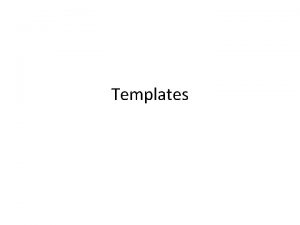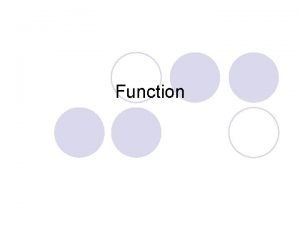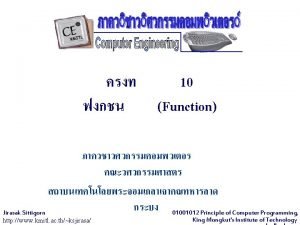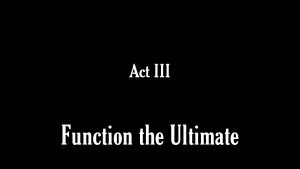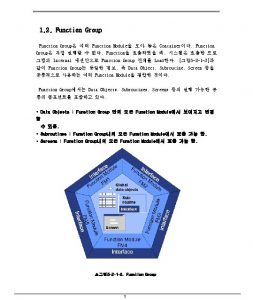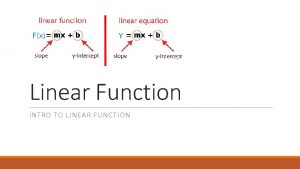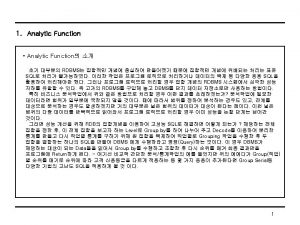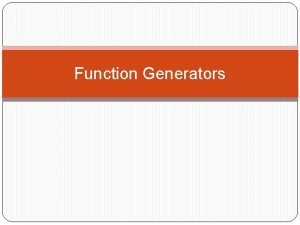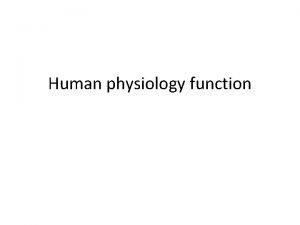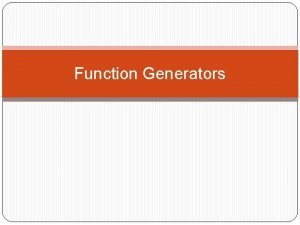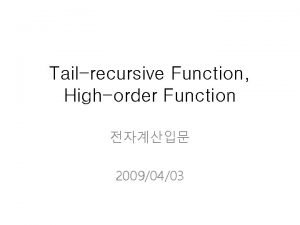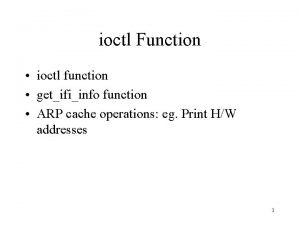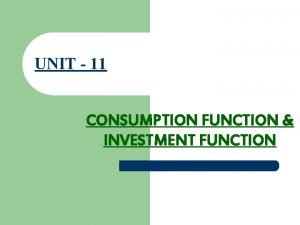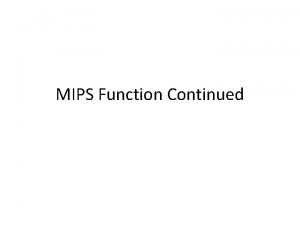Introduction to C Templates C Function Templates l























- Slides: 23

Introduction to C++ Templates C++ Function Templates l C++ Class Templates l 2021/2/24 Copyright 2006, The Ohio State University

C++ Function Templates l Approaches for functions that implement identical tasks for different data types n Naïve Approach Function Overloading n Function Template Instantiating a Function Templates n l 2021/2/24 Copyright 2006, The Ohio State University

Approach 1: Naïve Approach l create unique functions with unique names for each combination of data types n n difficult to keeping track of multiple function names lead to programming errors 2021/2/24 Copyright 2006, The Ohio State University

Example void Print. Int( int n ) { cout << "***Debug" << endl; cout << "Value is " << n << endl; } void Print. Char( char ch ) { cout << "***Debug" << endl; cout << "Value is " << ch << endl; } void Print. Float( float x ) To output the traced values, we insert: { … Print. Int(sum); } void Print. Double( double d ) Print. Char(initial); { … Print. Float(angle); } 2021/2/24 Copyright 2006, The Ohio State University

Approach 2: Function Overloading (Review) • The use of the same name for different C++ functions, distinguished from each other by their parameter lists • Eliminates need to come up with many different names for identical tasks. • Reduces the chance of unexpected results caused by using the wrong function name. 2021/2/24 Copyright 2006, The Ohio State University

Example of Function Overloading void Print( int n ) { cout << "***Debug" << endl; cout << "Value is " << n << endl; } void Print( char ch ) { cout << "***Debug" << endl; cout << "Value is " << ch << endl; } void Print( float x ) To output the traced values, we insert: { Print(some. Int); } Print(some. Char); Print(some. Float); 2021/2/24 Copyright 2006, The Ohio State University

Approach 3: Function Template • A C++ language construct that allows the compiler to generate multiple versions of a function by allowing parameterized data types. Function. Template < Template. Param. List > Function. Definition Template. Param. Declaration: placeholder class type. Identifier typename variable. Identifier 2021/2/24 Copyright 2006, The Ohio State University

Example of a Function Template template<class Some. Type> Template parameter (class, user defined type, built-in types) void Print( Some. Type val ) { cout << "***Debug" << endl; cout << "Value is " << val << endl; } Template argument 2021/2/24 To output the traced values, we insert: Print<int>(sum); Print<char>(initial); Print<float>(angle); Copyright 2006, The Ohio State University

Instantiating a Function Template • When the compiler instantiates a template, it substitutes the template argument for the template parameter throughout the function template. Template. Function Call Function < Template. Arg. List > (Function. Arg. List) 2021/2/24 Copyright 2006, The Ohio State University

A more complex example template<class T> void sort(vector<T>& v) { const size_t n = v. size(); for (int gap=n/2; 0<gap; gap/=2) for (int i=gap; i<n; i++) for (int j=i-gap; 0<j; j-=gap) if (v[j+gap]<v[j]) { T temp = v[j]; v[j] = v[j+gap]; v[j+gap] = temp; } } 2021/2/24 Copyright 2006, The Ohio State University

Summary of Three Approaches Naïve Approach Different Function Definitions Different Function Names Function Overloading Different Function Definitions Same Function Name Template Functions One Function Definition (a function template) Compiler Generates Individual Functions 2021/2/24 Copyright 2006, The Ohio State University

Class Template • A C++ language construct that allows the compiler to generate multiple versions of a class by allowing parameterized data types. Class Template < Template. Param. List > Class. Definition Template. Param. Declaration: placeholder class type. Identifier typename variable. Identifier 2021/2/24 Copyright 2006, The Ohio State University

Example of a Class Template template<class Item. Type> class GList Template { parameter public: bool Is. Empty() const; bool Is. Full() const; int Length() const; void Insert( /* in */ Item. Type item ); void Delete( /* in */ Item. Type item ); bool Is. Present( /* in */ Item. Type item ) const; void Sel. Sort(); void Print() const; GList(); // Constructor private: int length; Item. Type data[MAX_LENGTH]; }; 2021/2/24 Copyright 2006, The Ohio State University

Instantiating a Class Template • • • Class template arguments must be explicit. The compiler generates distinct class types called template classes or generated classes. When instantiating a template, a compiler substitutes the template argument for the template parameter throughout the class template. 2021/2/24 Copyright 2006, The Ohio State University

Instantiating a Class Template To create lists of different data types // Client code template argument GList<int> list 1; GList<float> list 2; GList<string> list 3; Compiler generates list 1. Insert(356); list 2. Insert(84. 375); distinct class types list 3. Insert("Muffler bolt"); GList_int list 1; GList_float list 2; GList_string list 3; 2021/2/24 Copyright 2006, The Ohio State University 3

Substitution Example class GList_int { int public: void Insert( /* in */ Item. Type item ); int void Delete( /* in */ Item. Type item ); bool Is. Present( /* in */ Item. Type item ) const; private: int length; Item. Type data[MAX_LENGTH]; }; int 2021/2/24 Copyright 2006, The Ohio State University

Function Definitions for Members of a Template Class template<class Item. Type> void GList<Item. Type>: : Insert( /* in */ Item. Type item ) { data[length] = item; length++; } //after substitution of float void GList<float>: : Insert( /* in */ float item ) { data[length] = item; length++; } 2021/2/24 Copyright 2006, The Ohio State University

Another Template Example: passing two parameters template <class T, int size> class Stack {. . . non-type parameter T buf[size]; }; Stack<int, 128> mystack; 2021/2/24 Copyright 2006, The Ohio State University

Standard Template Library l l l In the late 70 s Alexander Stepanov first observed that some algorithms do not depend on some particular implementation of a data structure but only on a few fundamental semantic properties of the structure Developed by Stepanov and Lee at HP labs in 1992 Become part of the C++ Standard in 1994 2021/2/24 Copyright 2006, The Ohio State University

What’s in STL? Container classes: vector, list, deque, set, map, and etc… l A large collection of algorithms, such as reverse, swap, heap, and etc. l 2021/2/24 Copyright 2006, The Ohio State University

Vector l A sequence that supports random access to elements n Elements can be inserted and removed at the beginning, the end and the middle n Constant time random access n Commonly used operations – begin(), end(), size(), [], push_back(…), pop_back(), insert(…), empty() 2021/2/24 Copyright 2006, The Ohio State University

Example of vectors // Instantiate a vector<int> V; // Insert elements V. push_back(2); // v[0] == 2 V. insert(V. begin(), 3); // V[0] == 3, V[1] == 2 // Random access V[0] = 5; // V[0] == 5 // Test the size int size = V. size(); // size == 2 2021/2/24 Copyright 2006, The Ohio State University

Take Home Message l Templates are mechanisms for generating functions and classes on type parameters. We can design a single class or function that operates on data of many types – function templates – class templates 2021/2/24 Copyright 2006, The Ohio State University
 Alter introduction templates
Alter introduction templates Essay structure
Essay structure Intro to piecewise functions
Intro to piecewise functions Introduction to quadratic functions
Introduction to quadratic functions Why do we study thermodynamics
Why do we study thermodynamics Rational functions parent function
Rational functions parent function Parent function for rational functions
Parent function for rational functions Pressure is state function or path function
Pressure is state function or path function Inverse square parent function
Inverse square parent function Non linear graph
Non linear graph Which of these is an exponential parent function
Which of these is an exponential parent function Pressure is state function or path function
Pressure is state function or path function Relation and function
Relation and function Linear parent functions
Linear parent functions Absolute value functions as piecewise functions
Absolute value functions as piecewise functions Identify polynomial function
Identify polynomial function A rational function of the form
A rational function of the form How a predicate function become a propositional function?
How a predicate function become a propositional function? Linear quadratic cubic reciprocal
Linear quadratic cubic reciprocal One one function and onto function
One one function and onto function The inverse of exponential function is a composite function
The inverse of exponential function is a composite function Functions and inverses
Functions and inverses Rumus fungsi permintaan
Rumus fungsi permintaan Polynomial function parent function
Polynomial function parent function
